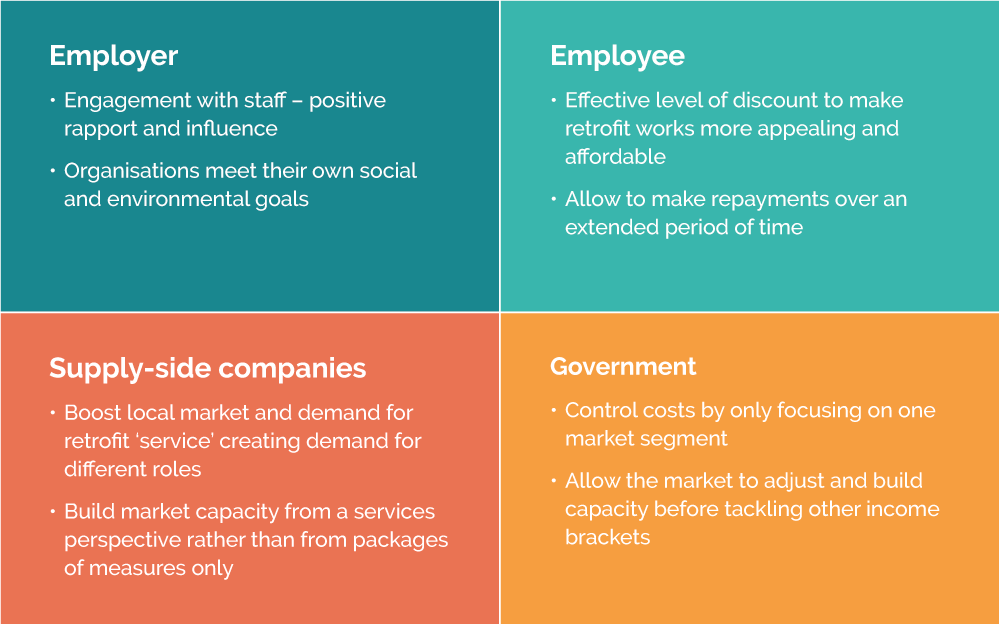CREDS researchers have developed an innovative idea – the Retrofit Salary Sacrifice scheme – designed to allow employees to invest in retrofit to improve their home-work environment which is repaid via gross salary contributions.
In the last ECEEE 2021 Summer study Marina Topouzi and Peter Mallaburn presented the Retrofit Salary Sacrifice scheme – an innovative idea they developed for a financial retrofit incentive. Here, together with Tedd Mose they look at it through the lens of multiple benefits in terms of equality and legal implications in policy.
What does ‘flexible working from home’ mean?
The Covid-19 pandemic has fundamentally reshaped the ways in which people work. Working from home has clearly come to stay as a new working practice. Since 2019, the accelerated trend of home-working has dramatically increased by up to 36.5% during lockdown, and remains high despite the easing of restrictions in the ‘new normal’ (Felstead and Reuschke 2020, Office for National Statistics 2021).
‘Smart’ or ‘flexible’ working, as in the UK’s lawOpens in a new tab, only contemplates an employee requesting to work flexibly in terms of time or location. The definition, ‘a way of working that suits an employee’s needs’, nonetheless, has been altered by Covid-19 restrictions meaning that working remotely is not always employees’ choice or favourable to their needs. The balance between companies and their staff has changed as the former outsource their operations – and part of their office stock- to their employees’ homes.
This has a series of work implications in terms of carbon inequality, inclusivity, suitability of building environment, and energy resilience for employees’ homes to accommodate the extra working activity and costs. In this, not all classes of employment are similarly affected. Junior and early career employees, renters, house-sharers, etc bear a disproportionately higher burden of home working implications. Companies and institutions, still in the momentum of the pandemic, continue to downsize their office space shifting their carbon emissions from the office to employees’ houses. While they absolve themselves of responsibility for environmental comfort, wellbeing and satisfaction – from desk and screen set-ups to other Indoor Environmental Qualities (IEQ) like lighting, heating, noise etc- to their employees.
We consider new flexible working practices an opportunity to address these issues and redefine mainstream equitable practices, bring multiple benefits to different actors and sectors, and avoid new forms of energy and social inequality.
Home working: A trigger to improve housing stock
Recognising the failures of previous policies in the building sector to deliver net-zero/low-carbon retrofit, we’ve developed the Retrofit Salary Sacrifice (RSS) scheme which identifies working from home as a trigger for a specific subgroup of salaried “able to pay” homeowners to increase awareness and undertake whole-house retrofit works. The challenge for retrofitting the owner-occupied sector is enormous and ‘able-to-pay’ doesn’t necessarily mean ‘able-to-retrofit’ if there isn’t any incentive or support.
The Retrofit Salary Sacrifice scheme follows the principles of previous established schemes (i.e. Cycle to Work). It is designed to allow employees to invest in a whole house assessment and retrofit (or repair and maintenance) planning to improve their home-work environment which is repaid via gross salary contributions. The scheme is designed not as a standalone retrofit finance option but as part of a policy mix. In design terms, this scheme is, essentially, a ‘multiple-benefits’ approach (IEA 2014) with a range of positive outcomes.

Image text
Employer
- Engagement with staff – positive rapport and influence
- Organisations meet their own social and environmental goals
Employee
- Effective level of discount to make retrofit works more appealing and affordable
- Allow to make repayments over an extended period of time
Supply-side companies
- Boost local market and demand for retrofit ‘service’ creating demand for different roles
- Build market capacity from a services perspective rather than from packages of measures only
Government
- Control costs by only focusing on one market segment
- Allow the market to adjust and build capacity before tackling other income brackets
This scheme comes as a catalyst to de-risk retrofit policy, and support market asset value and economic development. It involves a ‘retrofit service’ that connects green finance, project management and appraisal of a building’s condition and operation. It helps to sustain employers’ reputation by balancing their outsourced operations and acknowledging the inequalities of working remotely. The aim is to avoid, for example, early career workers ‘subsidising’ the employers to a greater extent than senior staff, while they use a higher proportion of their income to transform their house to a working space which is not necessarily energy efficient or future proofed. Supporting energy efficient home improvements, it also creates a conducive and healthy workplace for the home office environment; increasing benefits in wellbeing and productivity.
From a multiple benefit perspective, the Retrofit Salary Sacrifice approach highlights that law, policy, and regulation need to evolve to support flexible working employment and carbon equality. Flexible or ‘smart’ working needs to be a fundamental term in public employment law instruments (legislation) and private law documents (employment contracts) to ‘normalise’ it as working practice. Working from home needs to be seen as a trigger for building stock improvement among other benefits and not as a perverse incentive that retains remote working at the expense of more vulnerable staff. In this ‘new normal’, financial incentives like the Retrofit Salary Sacrifice promote changes towards energy efficiency for an equitable working environmentOpens in a new tab and employment.
Banner photo credit: Ronstik on Adobe Stock



